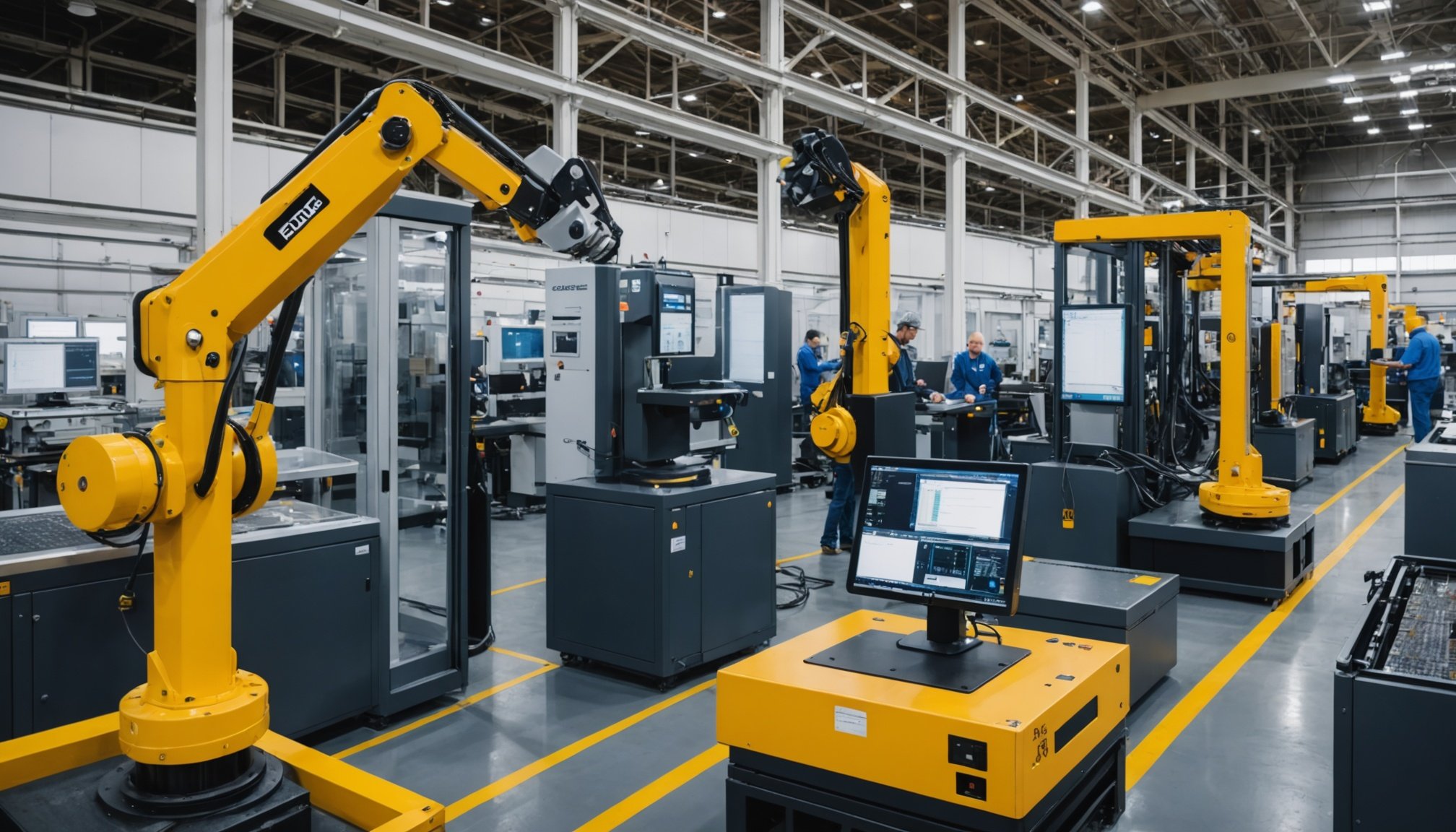Understanding Edge Computing in Smart Manufacturing
The integration of Edge Computing within Smart Manufacturing is transforming how data is processed. Edge computing refers to the practice where computation and data storage are performed near the data source, rather than relying on a central cloud-based location. This model is critical in Smart Manufacturing as it allows for Real-Time Analytics, enabling rapid decision-making and enhancing operational efficiency.
In the realm of smart manufacturing, edge computing plays a pivotal role by facilitating immediate data processing. This is crucial because manufacturing environments require swift responses to changing conditions on the factory floor. For instance, using Real-Time Analytics, machines can autonomously adjust to anomalies, reducing downtime and increasing production outputs.
Also to see : Creating a cutting-edge ai-driven system for secure autonomous vehicle navigation: your comprehensive step-by-step handbook
When comparing Edge Computing versus cloud computing in manufacturing, the key difference lies in latency and bandwidth utilization. Edge computing stores and analyses data onsite, significantly reducing latency compared to cloud computing, where data must travel back and forth to a central server. This increased responsiveness can lead to increased productivity and better energy management.
In conclusion, integrating Edge Computing into Smart Manufacturing not only improves process efficiency but also supports the creation of more adaptive and intelligent systems. By leveraging Real-Time Analytics, manufacturers can optimise operations, making informed decisions with precision and confidence.
Have you seen this : Revolutionizing document security: a comprehensive guide to implementing blockchain for effective management
Enhancing Real-Time Insights
In today’s fast-paced world, real-time insights are paramount for businesses seeking a competitive edge. Edge computing plays a crucial role by enabling instantaneous data processing. It allows data to be analysed at the source, reducing latency and enhancing analytics improvement.
One real-world example is in the retail sector, where edge computing is revolutionising customer experience. Stores equipped with IoT sensors and cameras can instantly analyse shopper behaviour, adjusting displays or offering personalised promotions. This real-time feedback loop significantly enhances customer satisfaction.
Another compelling case study is in the healthcare industry. IoT-enabled devices, such as smart medical instruments, collect critical patient data and process it at the edge. This allows healthcare professionals to make immediate, data-driven decisions, improving patient outcomes and operational efficiency.
IoT devices are integral to this process, transforming raw data into actionable insights. These devices gather a wealth of information, feeding it into edge computing systems for swift analysis. In smart cities, for instance, IoT sensors monitor traffic conditions and environmental factors, providing real-time data to optimise urban planning and resource allocation.
By leveraging edge computing and IoT technologies, organisations can harness the power of real-time insights, driving rapid and informed decision-making. This synergy not only boosts operational efficiency but also enhances strategic planning capabilities.
Tangible Benefits of Edge Computing
Edge computing offers several tangible benefits that significantly impact technological operations. One of the primary advantages is latency reduction. By processing data closer to the source, edge computing minimizes the delay often experienced in centralized systems. This instant data processing ensures faster response times, which is crucial in applications like real-time analytics and critical decision-making scenarios.
Another key benefit is the efficiency improvement seen across various sectors. By enabling localized data processing, edge computing enhances the speed and reliability of system operations, reducing the dependency on consistent internet connections. This results in smoother and more reliable processes, enhancing productivity in smart manufacturing environments where real-time data is pivotal for operational success.
Edge computing also contributes to substantial cost savings. By decreasing the amount of data sent to centralized data centers, companies can significantly cut down on bandwidth usage and associated costs. The reduced need for expansive data storage infrastructures further lowers expenses, allowing more funds to be allocated towards innovation and development initiatives.
By combining these advantages, edge computing bolsters decision-making processes in smart manufacturing contexts. By providing rapid data insights and streamlined operations, businesses are equipped to make informed decisions, fostering competitive advantage and innovation.
Use Cases of Edge Computing in Smart Manufacturing
Edge computing is revolutionizing smart manufacturing by enabling data processing closer to the source. This results in faster decision-making and improved efficiency.
Predictive Maintenance
Predictive maintenance leverages real-time monitoring to predict equipment failures before they occur. Edge computing plays a crucial role by processing data locally, thus reducing latency and enabling immediate responses. Manufacturers can perform real-time analytics on machinery data to anticipate part failure, scheduling maintenance only when needed, and reducing downtime. This approach enhances reliability and boosts production efficiency, resulting in cost savings and prolonged machinery lifespan.
Quality Control Automation
In the realm of quality control automation, edge computing enables immediate defect detection in manufactured components. By analysing images and sensor data at the edge, manufacturers can ensure higher quality production standards. This real-time processing helps in making instant decisions about non-conforming products, reducing waste, and improving customer satisfaction. The localized nature of edge computing means lower data transfer costs and increased processing speed.
Supply Chain Optimization
Edge computing optimizes the supply chain by analysing logistics data at the source, leading to enhanced efficiency. This real-time data processing supports decisions on inventory management, demand forecasting, and delivery scheduling. By providing actionable insights through edge analytics, manufacturers can reduce lead times, minimize risk, and respond swiftly to market changes, ensuring a seamless flow of goods from production to delivery.
Best Practices for Implementing Edge Computing
Deploying edge computing effectively in manufacturing requires thoughtful consideration and strategic planning. To begin with, a key aspect is the integration of existing systems with new edge technologies. This involves understanding the current infrastructure and identifying opportunities for synthesis, ensuring a seamless transition that maximises efficiency while minimising disruptions.
One of the first steps in the implementation process should be conducting a comprehensive assessment of existing assets. This will help identify which components are ripe for edge integration and how they can be leveraged to enhance operational performance. Implementing edge computing is not just about adopting new technology, but about enriching and expanding the capabilities of existing systems.
Future-proofing your edge infrastructure is critical for maintaining competitive advantage. This involves anticipating technological advancements and developing adaptable systems that can evolve alongside innovations. Designing with scalability in mind ensures that your systems can grow without requiring a complete overhaul.
Strategic planning is essential throughout this process. Knowing the specific requirements and limitations of your manufacturing environment allows you to tailor edge solutions effectively. Collaborating with experts can offer insights into the latest trends, tools, and opportunities, enhancing your edge computing infrastructure’s resilience and functionality.
Ultimately, strategic implementation of edge computing will drive innovation, efficiency, and unprecedented benefits for modern manufacturing.
Challenges and Solutions in Edge Computing Adoption
Adopting edge computing presents distinct challenges that organizations must navigate to harness its full benefits. A primary hurdle is the implementation barriers related to infrastructure. Many companies lack the necessary hardware and network configurations to support distributed computing at the edge. This lack of infrastructure can impede deployment timelines and raise costs, causing frustration among IT teams and stakeholders eager for faster results.
To address these challenges, a phased approach to implementation can be advantageous. By initially deploying edge computing in select areas, organizations can test and refine strategies with lower risk and investment. It’s crucial for teams to engage in thorough planning and to anticipate potential integration issues with existing systems. Moreover, relying on cloud-edge hybrid models can offer a balanced solution, bridging the gap until full edge computing infrastructure is in place.
A well-prepared workforce is fundamental in overcoming implementation barriers. Training programs should emphasize upskilling in areas related to edge device management, data analytics, and cybersecurity. Developing such expertise within teams not only ensures smoother transition to edge computing but also fosters innovation and swift adaptation to evolving technologies. Invest in continuous training and workforce development to empower employees and ensure the long-term success of edge projects.
Expert Opinions and Future Trends
The field of edge computing is rapidly transforming, especially within smart manufacturing. Industry experts have pinpointed several emerging trends and technologies that are set to redefine this landscape. One significant trend is the integration of artificial intelligence and machine learning at the edge. This allows for data to be processed and analyzed locally, reducing latency and increasing the efficiency of smart manufacturing processes.
Expert insights also highlight the growing importance of cybersecurity in edge computing. As more devices become interconnected, the risk of data breaches escalates. Implementing robust security measures is deemed crucial by industry leaders to protect sensitive manufacturing data.
Furthermore, the adoption of 5G technology is predicted to further enhance the edge computing landscape. Experts suggest that the ultra-fast data transmission capabilities of 5G will greatly benefit manufacturing, allowing for real-time data processing and improved communication between devices.
Industry predictions indicate a shift towards more decentralized computing infrastructures. This evolution is driven by the need for faster decision-making and increased flexibility in manufacturing operations. As edge computing continues to evolve, its role in smart manufacturing is expected to become even more integral, driving innovation and improving overall operational efficiency.











